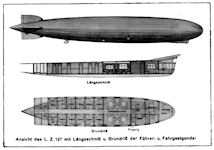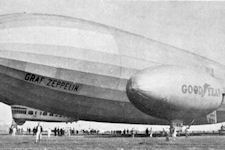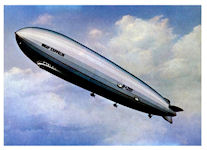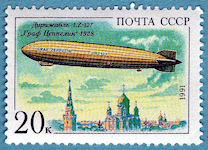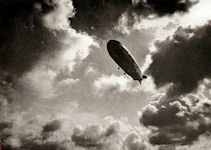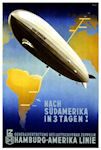LZ127 Graf Zeppelin
By 1920 the equipment at the Zeppelin Airship company's factory on the outskirts of Friedrichshafen comprised three good-sized factory buildings, the new laboratory, two airship sheds and a flying field. At that timee no construction was going on, the men who had been retained being engaged in clearing up old stock and in making other aluminum goods than airships, but the managers of the company were all set to go the minute that new construction or the operation of an airship transportation line on a large enough scale to be worth their while is permitted, and they were seeking orders in all directions. At that time the company employed two hundred men, a reduction from four thousand during the war. The airship sheds were occupied by the Nordstern and the Bodensee, without their gasbags in place. The Nordstern had never been inflated.
When the various restrictions imposed by the Treaty of Versailles on Germany were lifted, Germany was again allowed to construct airships. It built three giant rigid airships: the LZ-127 Graf Zeppelin, LZ-l29 Hindenburg, and LZ-l30 Graf Zeppelin II.
The culmination of Zeppelin development was the Graf Zeppelin and Hindenburg airships, unquestionably outstandinq engineering achievements for their day. The early airships were designed primarily by empirical methods, and the only company to accumulate sufficient experience to design successful rigid airships was the Zeppelin Company. Two areas in which there was a serious lack of knowledge were aerodynamic loads and design criteria. But it is generally acknowledged today that past conventional, fully buoyant airship designs were very nearly optimum for this class of vehicle in terms of aerodynamic shape and fineness ratio.
The keel was laid for the Graf Zeppelin [ie, Count Zeppelin] in 1926. Called the "most beautiful airship of them all", she was 775 feet long, 100 feet in diameter, developed a speed of 70mph, had five 530hp Maybach engines, and had a 6,250 mile unrefuelled range. She carried a crew of 44, with accommodations for 20 passengers, and had a dining room and saloon. The Hindenburg, launched seven years later (March, 1936) had four 1050hp Daimler-Diesel engines, a top speed of 81mph, a similar range to the Graf Zeppelin, and carried 100 people.
Launched on 18 September, 1928, the Graf Zeppelin made over 650 flights, 144 of them across the North and South Atlantic, logged over a million miles, and carried more than 18,000 passengers. A typical east-west crossing from Friedrichshafen to Lakehurst took about 79 hours, with a return journey averaging about 60 hours due to favorable winds.
In August 1929, the German airship Graf Zeppelin flew around the world in four stops, traveling 31,000 miles in 21 days, 12 hours, carrying twenty passengers and forty-one crew. The longest leg was a nonstop flight between Friedrichshafen, Germany and Tokyo, a distance of over 7,000 miles covered in 100 hours. Its flight began with a trip from Friedrichshaften, Germany, to Lakehurst, New Jersey, allowing William Randolph Hearst, who had financed the trip in exchange for exclusive rights to the story, to claim that the voyage began from American soil. Piloted by Eckener, the craft stopped only at Tokyo, Japan, Los Angeles, California, and Lakehurst. The trip took 12 days-less time than the ocean trip from Tokyo to San Francisco.
Not only was a flight like this unthinkable by an airplane in 1929, the passengers made the flight in accommodations unavailable to the commercial air traveler even today. The spacious dining room of the Graf Zeppelin makes another point about airships. Because the gas envelope is necessarily many times larger than the fuselage of an airplane of comparable gross weight, they tend to have much more volume available for passengers and cargo. It is much more difficult to bulk-out an airship than an aircraft.
The vehicle was lifted by the buoyancy of the lifting gas and all the engines must do is overcome parasitic drag to move the vehicle through the air. This explains the remarkable performance of airships such as the LZ 59 and Graf Zeppelin given the limited performance of the internal combustion engines available at the time. The engines only had to move the airship, not lift it, and since the airships were relatively slow even the parasitic drag component was small.
In 1931 she undertook an aerial survey of the Arctic, carrying out several maritime stopovers in the process. The conception of the Graf Zeppelin's Arctic cruise of 1931 dated to 1926 and the foundation of the Aeroarctic Society. In its first form the plan was for a crossing of the Arctic from the European to the American side under the leadership of Nansen. The plan failed to mature, largely on account of the extremely high rates of insurance expected for a dirigible navigating so far north. Nansen's sudden death in 1930 brought a further postponement until the election of Dr. Hugo Eckener to the presidency of Aeroarctic later in the same year.
At 8.35 a.m., the morning of July 24, the monstrous bulk of the Graf Zeppelin began to move slowly out of its Friedrichshafen hangar; and a few minutes later we were headed northward towards Berlin, on a course northward for Helsingfors, thence east for Leningrad. The Arctic Circle was crossed at 7 p.m on July 26. The wind, which had been light from the northeast all day, suddenly shifted to east-northeast and increased to a fresh breeze almost coincident with reaching the Arctic Sea. As the dirigible progressed farther north, the thermometer dropped to 2" C., and the ship gradually emerged into clear atmosphere and bright sunshine. The Graf Zeppelin stopped at Templehof field for a half hour, then left for Friedrichshafen, the final destination, which was reached at 5 a. m., July 31, 1931.
One of the most important contributions of the Graf Zeppelin expedition was the correction of existing maps. The subject of photogrammatic survey in Franz Josef Land was, particularly, Alexandra Land and a portion of Prince George Land. In Novaya Zemlya the northern and southern limits of the inland ice were photographed with the mapping cameras, as also were unrecorded mountain peaks that protrude through the ice along the meridional ridge of the island in its northern part.
The Graf Zeppelin expedition, unlike all other aircraft explorations of the Arctic, was made during midsummer, a season usually attended with much fog and low visibility. However, it seemed that given certain winds and pressure conditions this handicap could be avoided. It was designated as a preliminary cruise to a longer flight to take place either in the summer of 1932 or 1933. The U.S. Coast Guard, with its International Ice Patrol researches, was for one much interested in these airship investigations in the Arctic. It hoped to see a successful flight along the iceberg-glacier fronts of Baffin Bay and to realize a camera study of the iceberg distribution in West Greenland waters.
She was retired from service in 1937. During the 10 years the Graf Zeppelin flew, it made 590 flights including 144 ocean crossings. It flew more than one million miles (1,609,344 kilometers), visited the United States, the Arctic, the Middle East, and South America, and carried 13,110 passengers. The Graf Zeppelin is considered the finest airship ever built. It flew more miles than any airship had done to that time or would in the future.
|
NEWSLETTER
|
| Join the GlobalSecurity.org mailing list |
|
|
|


